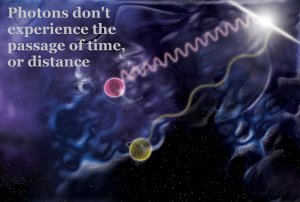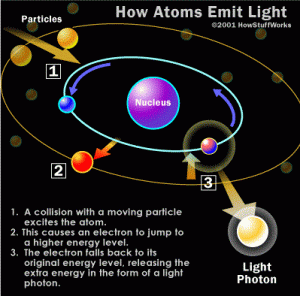
Photons, the mysterious carriers of the electromagnetic force – there’s more to them than reaches the eye. I’m going on a journey to the sub-atomic, to the quantum world, where things are much weirder than life here on Earth…

Whats in a name? I’ll say that a photon is a stable, gauge boson with no charge that is responsible for the electromagnetic force, and all light we observe in the universe. Much like other quantum &particles, photons can also be thought of in wave like forms (I’ll just think of them as particles for now though). Photons are also one of the few massless particles, which it turns out means a lot more than being the skinniest particle on the quantum block. In short, photons are created when some leptons (massive particles like the electron) and other electrically charged particles, have excess energy to spit out.
If you were somehow riding on top of a photon, you might spring into existence from an electron reducing its energy, a process which is called “spontaneous emission”.This should not be interpreted as–at the point of emission you (the photon) exists inside the electron’s point particle structure, you simply exist at the point of emission, you are not created or stored inside the electron.
What The… ?

As you may know, photons travel at the speed of light (299,792,458 m/s in a vacuum). The first question we ask is, “why does a photon travel at the speed of light?” Frankly, I hate that question. It should be rephrased as, “why does a photon HAVE to travel at the speed of light?” Simply put, as a photon, you don’t have mass, which means you can only travel at the speed of light. This is expressed mathematically here as $latex E^2=(pc)^2+(m_0c^2)^2&s=1$ When the rest mass $latex m_{0}&s=1$of a particle (photon) is zero, the equation simplifies to $latex E=pc&s=1$, relating a photon’s energy $latex (E)&s=1$ to its momentum $latex (p)&s=1$ times the speed of light $latex (c)&s=1$.
This essentially just means that you (a photon) enters existence at the speed of light, and throughout your whole “lifespan” will travel at the speed of light. This is all fun and games, until you start to think about what that really means. You see, as you approach the speed of light time starts to slow down.
This effect is called “Time Dilation.” If you were riding on, say, an electron traveling very close to the speed of light, you would experience time as you normally do – but an outside observer would (if they could) see you aging eternally slow…for time has come to a crawl according to their reference frame. However at the speed of light, which we found the photon has to go, time is completely stopped. You would not age, your metabolic processes would cease, and there has been debate about whether consciousness is possible at light speed.
As you travel through space, your photon will not experience distance either! Humans define distance as time x speed, but as you’re not experiencing time, you’re missing a key component of distance. As a photon, you just experience your initial existence (emission), then your final existence (absorption) with nothing in between.
Conclusion:
Life is much simpler for a photon, you don’t have to worry about radioactive decay or electromagnetic charge – you just fly around at the speed limit for the universe, absorbing and emitting through atoms at will. Distance? Who needs it, photons don’t have the time for that.
Related Articles: “Physical Consequences of Light-speed Travel,” “What Does Moving Through Space-time Mean?,” “According to Science, TARDIS Could Exist,” A Sunshine Holiday: A Photon’s Journey Through the Sun”